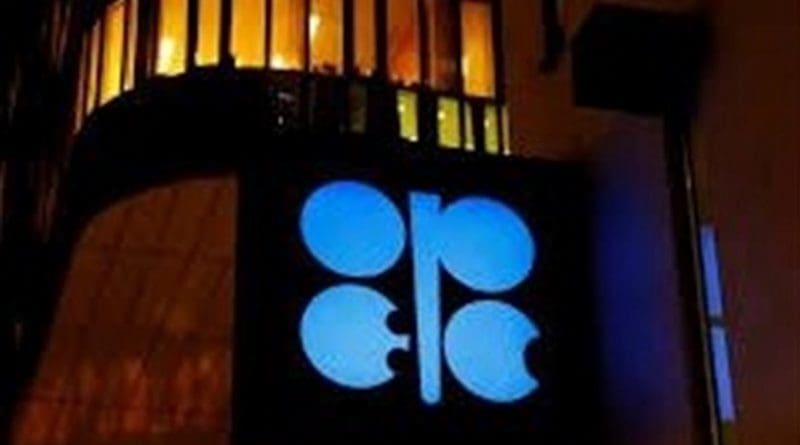OPEC Plus Agree To Deeper Cuts – OpEd
Oil producers’ cartel led by Saudi Arabia and Russia agreed on Friday, 5th December 2019 for deeper oil output cuts during the first quarter of 2020, aiming at averting oversupply and supporting prices. The group of more than 20 oil producers agreed to cut an extra 500,000 barrels per day (bpd). The cartel seems fully cognizant of overflowing crude oil market, weak refining margins and no excess inventory.
The cut has come at a time of year when demand should be the strongest and should also add pressure to hike product prices. While the market response may be muted, the decision is likely to give price a support. By agreeing a 500,000 bpd cut based on 2018 levels, OPEC has put itself into a box. In order to achieve compliance the pressure is now on those producing above their quotas. A 500,000 bpd reduction does not alter the outlook for H1 2020, as global markets will remain oversupplied.
In his first interview with Reuters since he became energy minister in September, Prince Abdulaziz bin Salman said he expected OPEC+ producers to continue cooperating beyond March. He also said, OPEC and its allies would only ease supply curbs and pumps more oil once global crude inventories fall and pricing reflects a tighter market. OPEC+ producers pump more than 40% of the world’s oil and have constrained output since 2017 in an effort to balance rapidly rising output from the United States.
While all oil producers would like to increase output, Saudi Arabia would only do so when it saw global inventories fall, he said. Saudi Arabia would like to see stocks within the range of the last five years and the average of 2010-2014, he added.
The minister also stressed the need for producers such as Iraq and Nigeria to improve their compliance with promised cuts. Even if their compliance did not improve, Riyadh would not raise output unilaterally but instead would wait for consultations with OPEC+ at its next meeting in early March. He also said that he expected a resumption of production from oilfields jointly operated by Saudi Arabia and Kuwait very soon. But it would not affect both our countries’ commitments (with OPEC+ cuts). The two countries halted output from the Khafji and Wafra oilfields more than three years ago, cutting some 500,000 bpd of supply.
The cut of 500,000 bpd is just symbolic as the targets are just brought closer to the current output level. But if the new cut means that another 500,000 bpd are taken from the market – then prices may stabilize. Demand to grow by 900,000 bpd in 2020, but supply to be stronger, leading to a surplus of 800,000 bpd. Cut of proposed 500,000 bpd could shrink surplus to 300,000 bpd.
The most crucial thing for OPEC now seems unity within the Organization. Production cut said to be split roughly 2/3 OPEC, 1/3 non-OPEC producers. However, adherence to cuts seems unlikely. Saudi Arabia has made it abundantly clear to other OPEC+ participants that it is no longer willing to shoulder the burden of supporting oil prices when others want. Saudi Arabia won some sympathy from fellow members due to the Aramco IPO.
If one explores the likely outcome of an extension of cuts with only the official quota of OPEC+ being reviewed lower, rather than actual production, then the change in supply policy would be cosmetic given below target production in some countries, notably Saudi Arabia and Angola. OPEC would still face imbalances in 2020 suggesting oil inventory builds that can come to negatively impact on oil prices.
“The idea of extending the current agreement until mid-2020 seems to be off the table. In addition, Russia will be allowed to exclude the oil condensates that occur as a by-product of natural gas production when calculating its oil production relevant to the cuts. This corresponds to standard OPEC practice.
It is believe that OPEC+ decision not likely to make much difference as the oversupply in the first quarter of 2020 is far higher than 500,000 barrels per day. It remains unclear how the sizeable oversupply that will likewise be seen in the second quarter. Oil prices are likely to remain subdued in near term due to lower demand in 2020, because of soft demand, rising supply from the US, Canada, Brazil and the North Sea. On top of all if prices start inching higher it would simply re-accelerate the US shale boom.


This is Trump’s effect. Trump has been taking a total of 500 billions from the KSA. The Saudis have to cover this large sum of money. The only way is to produce more oil or cut production. Production’s cut is the best choice. This raise along with winter will increase the price of oil to more than 70 dollar a barel.
Let say the price will hit 70 dollars, the Saudi will earn a large sum of revenue. Here is why:
Since Trump’s visit to the Kingdom and his Dancing with the Sword, the price of oil has been increasing from 42 dollars to even more than $70 per barel. On average the Kingdom obtained about $30 per barel a day. The Kingdom produces 11 million barel daily, which means it receives about 330 million a day which will provide about 120 billion a year. If the price differential due to Trump’s effect continues for four years, the first term for Trump in office, the Saudis will receive about 500 billion. This is very close to the money Trump claimed that he received from the Kingdom.
If Trump is re-elected the Saudis will obtain another half trillion or more due to Trump’s effect. That is to say, if the Kingdom has given Trump a half trillion, The Kingdom will get one trillion in return (100 return). Still, Trump thinks he is the Man of the best deals and knows more than others.